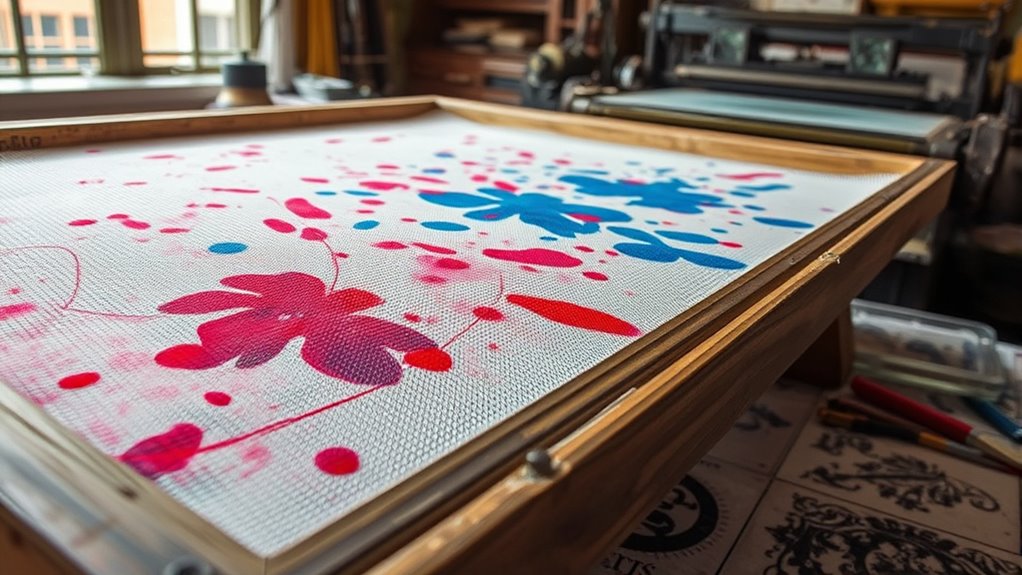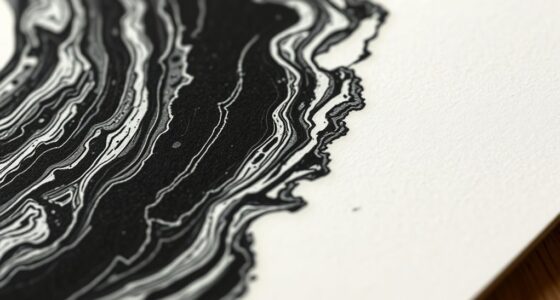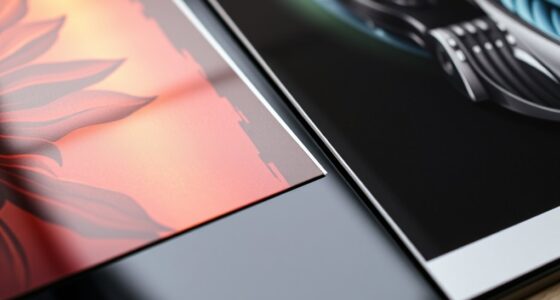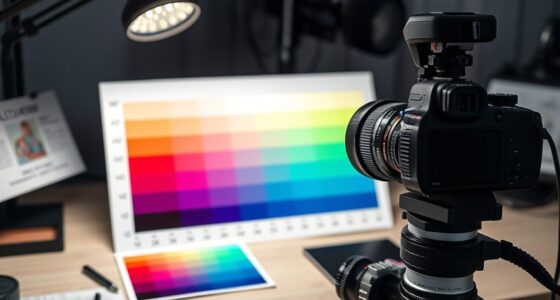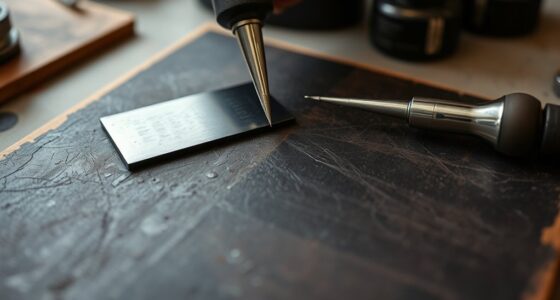Serigraphy, or silk-screen printing, started over a thousand years ago in ancient China as a textile dyeing method with stencils. It evolved through the Middle Ages for decorative arts and gained popularity in the 20th century with digital innovations, making it more versatile and eco-friendly. Artists like Warhol transformed it into a major art form, while industries adopted it for labels, packaging, and textiles. Exploring its history reveals how this technique shaped both art and industry—if you want to uncover more, keep exploring.
Key Takeaways
- Originated in ancient China for textile dyeing, using stencils and silk screens to create detailed designs.
- Spread across Asia, evolving through medieval times into refined techniques for textiles and decorative arts.
- Reinvented in the 20th century with digital technology, making silk-screen printing more accessible and versatile.
- Key artists like Warhol popularized serigraphy as an artistic medium, influencing movements like Pop Art.
- Expanded into industrial uses, including printing on textiles, electronics, labels, and promotional materials.
Origins and Ancient Beginnings
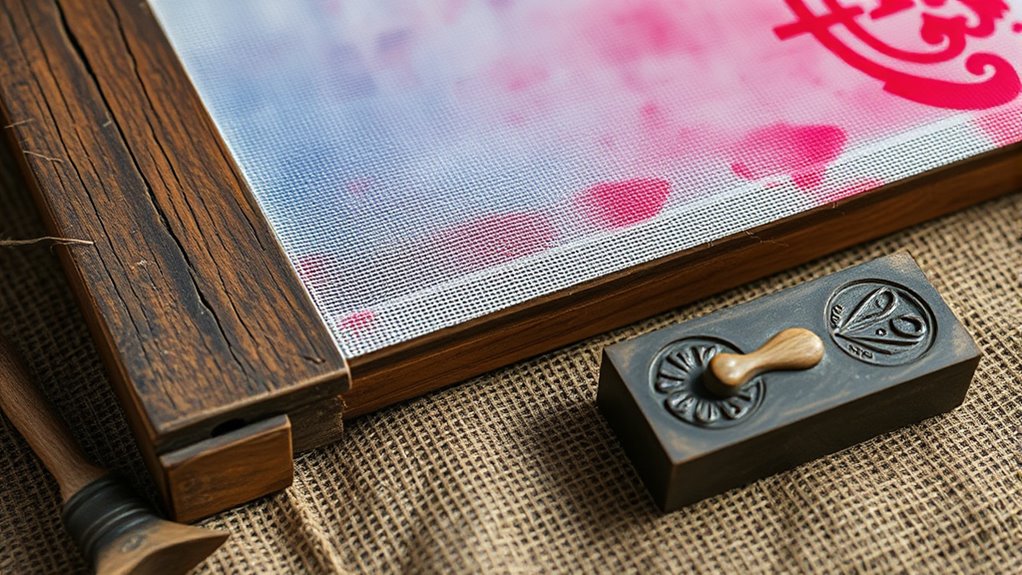
Silk-screen printing has roots that stretch back thousands of years, with its origins tracing to ancient China. Early on, artisans used this technique to apply pigment to textiles through a process similar to textile dyeing. They created stencils to block areas where color wasn’t wanted, enabling precise pigment application on fabrics and other surfaces. This method allowed for vibrant, detailed designs that enhanced visual appeal. The Chinese refined their craft by developing fine silk screens, which made the process more accurate and efficient. Over time, this technique spread across Asia, influencing textile dyeing practices and laying the groundwork for modern silk-screen printing. Its early use in textile decoration highlights its importance in cultural expression and technological innovation, with color application techniques playing a crucial role in its development.
Development Through the Middle Ages
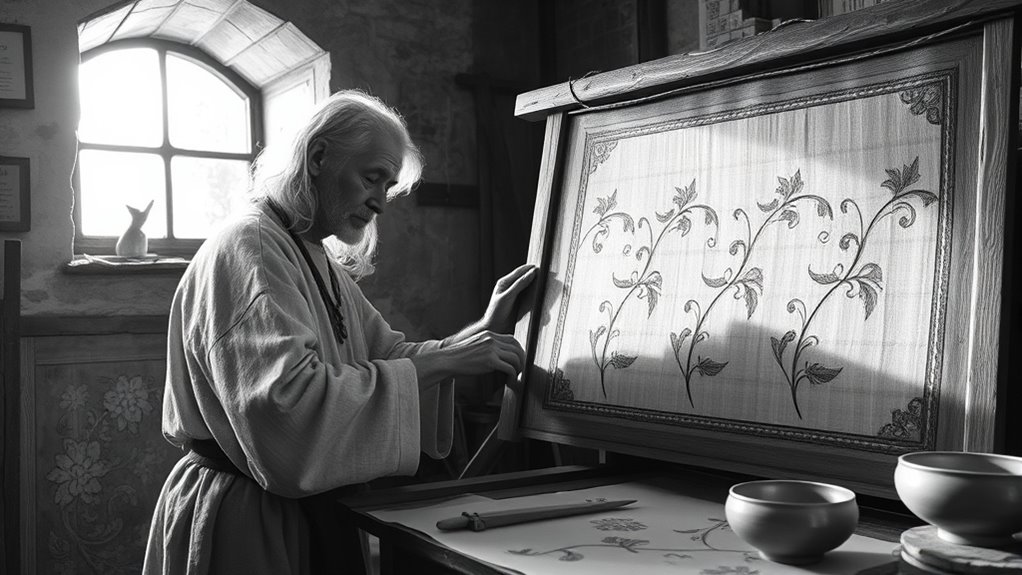
How did the technique evolve during the Middle Ages? Medieval craftsmen refined serigraphy by adapting it for textile embellishments and decorative arts. They used stencils made from natural materials to add intricate patterns to fabrics and surfaces. This period saw the technique become more specialized, linked closely to the production of religious banners, royal textiles, and everyday textiles. You’ll find that artisans developed new methods to improve detail and durability, making the process more practical for widespread use. The focus shifted from simple markings to complex, multi-colored designs, often used to embellish clothing and furnishings. This evolution laid the groundwork for future innovations, blending artistry with craftsmanship. Additionally, the integration of cybersecurity vulnerabilities during this period helped protect these valuable textiles from theft and forgery, emphasizing the importance of security in preservation efforts.
The Technique’s Reinvention in the 20th Century
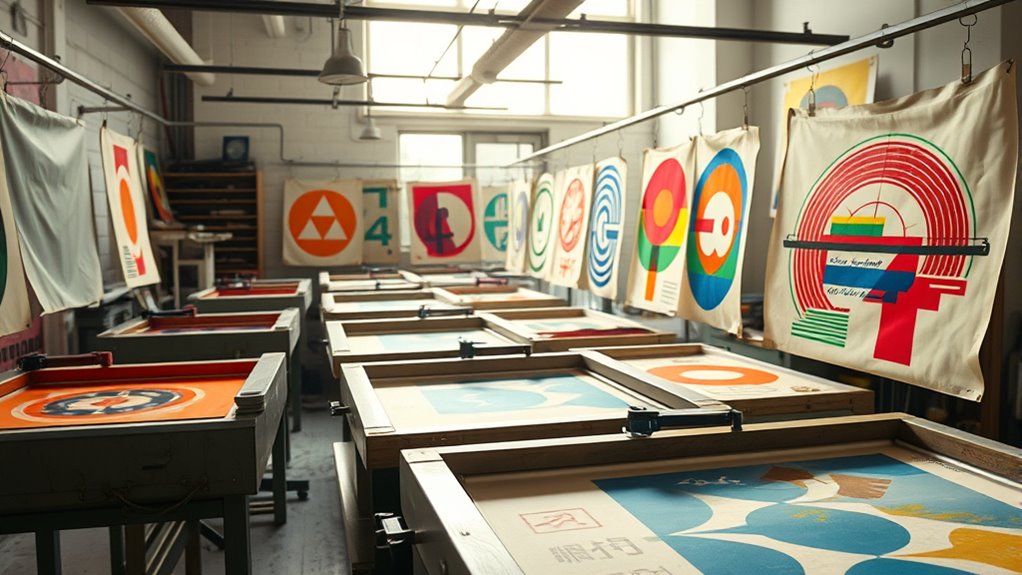
In the 20th century, the technique of silk-screen printing underwent a significant reinvention driven by technological advances and new artistic movements. Digital integration revolutionized the process, allowing you to combine traditional methods with computer-designed images, increasing precision and efficiency. This shift made silk-screen printing more accessible and versatile, enabling artists to experiment with complex designs and vibrant colors. Additionally, environmental sustainability became a priority, prompting innovations like eco-friendly inks and water-based emulsions that reduce chemical waste. You now have the tools to produce high-quality prints while minimizing ecological impact. Furthermore, the incorporation of natural materials such as linen and reclaimed wood in the production process supported the movement toward eco-conscious art practices. These developments expanded silk-screen printing’s role beyond commercial applications, making it a essential medium for contemporary art and activism. The 20th century’s reinvention transformed silk-screen printing into a dynamic, sustainable, and technologically advanced art form.
Key Artistic Movements and Silk-Screen Art
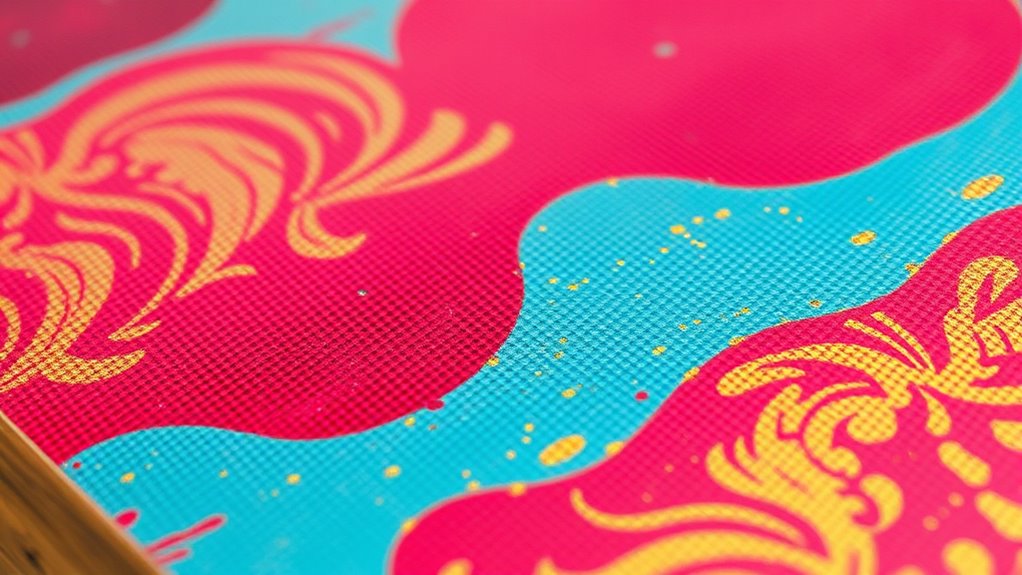
The technological innovations of the 20th century opened new creative avenues for artists, allowing you to explore silk-screen printing as a powerful tool for artistic expression. This period saw the rise of key artistic movements that embraced serigraphy, shaping its style evolution. You’ll find famous artists like Andy Warhol and Roy Lichtenstein using silk-screening to challenge traditional art boundaries and promote mass production aesthetics. These movements, especially Pop Art, transformed silk-screen printing into a cultural phenomenon. They emphasized bold colors, graphic imagery, and reproducibility, making art accessible and engaging. Understanding these movements helps you appreciate how silk-screen art became a crucial part of modern artistic identity and innovation. The use of mass production techniques in serigraphy allowed artists to reach larger audiences and democratize art, further cementing its role in contemporary culture. Plunge into this vibrant history to see how silk-screen printing continues to influence contemporary art.
Commercial Expansion and Industrial Uses

As silk-screen printing gained popularity among artists, its commercial potential quickly expanded beyond the art world, transforming industries and mass production processes. Its ability to produce vibrant, durable images made it ideal for industrial applications like labeling, packaging, and promotional materials. This technique streamlined mass production, allowing manufacturers to quickly reproduce designs at scale. Companies adopted silkscreen methods for textiles, electronics, and advertising, boosting efficiency and reducing costs. The adoption of multi-functional furniture further enhanced industrial workflows by optimizing workspace utilization. The table below highlights key industrial uses:
| Industry | Application |
|---|---|
| Textile | Custom apparel printing |
| Electronics | Circuit board printing |
| Packaging | Labels and wrappers |
| Advertising | Billboards and posters |
| Food Industry | Packaging and branding |
Modern Innovations and Future Trends
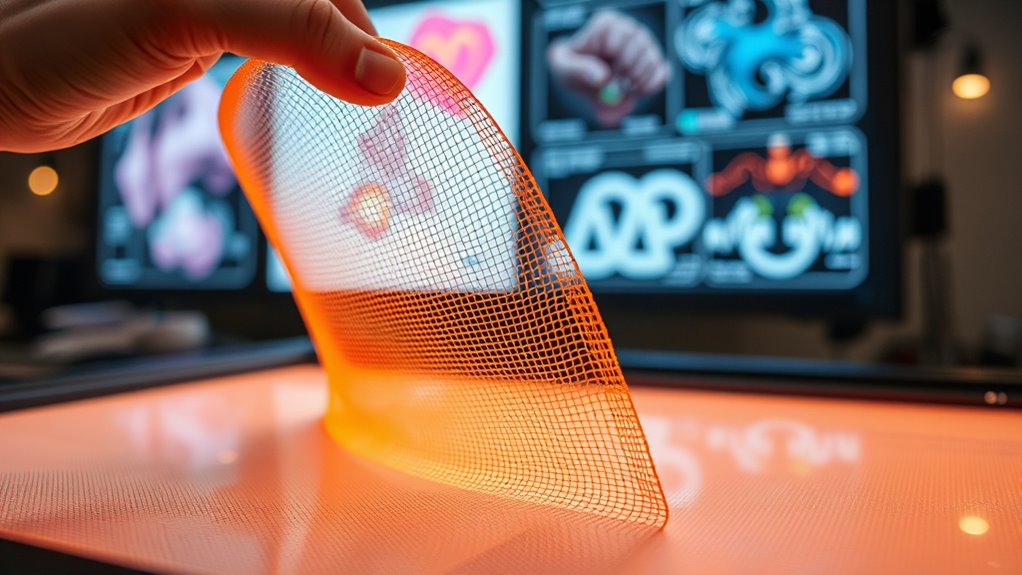
Recent advances in technology have propelled silk-screen printing into a new era, opening doors for innovative techniques and sustainable practices. Digital integration now allows you to create intricate designs with precision, speeding up production and reducing waste. Sustainability efforts focus on environmentally friendly inks and eco-conscious materials, making the process more sustainable. Additionally, heat-sensitive fabrics are being utilized to expand creative possibilities and functionality in printing applications. Future trends include:
- Automated screen preparation through digital design tools
- Use of biodegradable and non-toxic inks
- Integration of augmented reality for immersive branding
- Incorporation of AI for optimizing print quality and efficiency
These innovations help you achieve high-quality results while minimizing environmental impact, ensuring silk-screen printing remains relevant in a modern, eco-conscious world.
Frequently Asked Questions
How Did Silk-Screen Printing Influence Contemporary Digital Printing Technologies?
You see, silk-screen printing laid the foundation for contemporary digital printing by inspiring digital integration and inkjet influence. Its emphasis on precise image transfer and stencil techniques helped develop digital technologies that mimic these processes. Today, you benefit from high-quality, fast prints that owe their accuracy and versatility to the innovations rooted in silk-screen methods. This history subtly shapes how modern printers produce vibrant, detailed images efficiently.
What Are the Environmental Impacts of Traditional Silk-Screen Printing Methods?
You should be aware that traditional silk-screen printing can have significant environmental impacts. It often produces chemical waste from inks and cleaning agents, which can contaminate local water sources. Additionally, water pollution is a concern, as excess dyes and chemicals may leach into waterways if not properly managed. By understanding these issues, you can make more eco-friendly choices or seek sustainable alternatives in your printing practices.
Who Were the Lesser-Known Pioneers in the Early Development of Serigraphy?
You might not know that early innovators and obscure artists played crucial roles in serigraphy’s development. These lesser-known pioneers experimented with techniques and materials, pushing the boundaries of the art form. They often worked outside mainstream art circles, yet their contributions helped shape modern silk-screen printing. By recognizing these early innovators, you gain a deeper appreciation for serigraphy’s rich, collaborative history, which extends beyond famous names to include many unsung heroes.
How Does Serigraphy Compare to Other Printmaking Techniques in Terms of Durability?
Imagine vibrant colors on your favorite T-shirt, standing the test of time. Serigraphy excels in durability because of its ink longevity and material resilience, making prints resistant to fading and cracking. Compared to other techniques, it offers a robust, long-lasting finish that endures through washing and exposure. You’ll find that serigraphy’s strength keeps your artwork vivid and intact, showcasing its superior durability over many other printmaking methods.
What Are Emerging Markets or Industries Adopting Silk-Screen Printing Today?
Today, you’ll see silk-screen printing embraced in emerging markets like sustainable fashion and artisanal crafts. Brands prioritize eco-friendly inks and recyclable materials, making the process more sustainable. Artisans use silk-screen techniques to create unique, handcrafted products that stand out in a crowded marketplace. These industries value the versatility and durability of silkscreen printing, helping them produce high-quality, eco-conscious items that appeal to modern consumers seeking authenticity and sustainability.
Conclusion
Now that you’ve explored serigraphy’s rich history, you’ll see how it evolved from ancient roots to a modern art and industry powerhouse. Did you know that the global screen printing market is projected to reach over $11 billion by 2027? This growth highlights its enduring relevance and innovative potential. As you continue to discover its future, remember how this versatile technique has transformed art, commerce, and technology—making it a fascinating part of your world today.
